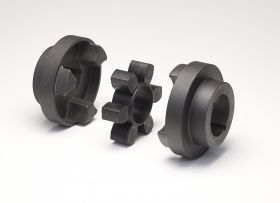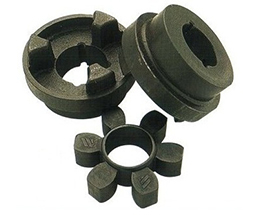Product Description
Gear coupling flexible Fluid Flange HRC Spacer PIN MH Rigid NM Jaw Steel chain brake standard drum wheel rolling shaft steel transmission parts
Ever-Power industry is 1 of the biggest couplings manufacturer in China, have already exported lots of gear couplings, Jaw couplings, chain couplings etc.. to Japan, Korea, Italy , USA …..
Application of Gear coupling
Gear couplings are used to connect 2 shafts that are not perfectly aligned. They do this by using gears to transmit torque between the shafts. Gear couplings are available in a variety of sizes and types, and they are used in a wide range of applications.
Some of the most common applications for gear couplings include:
- Pumps: Gear couplings are used to connect the motor to the pump in a variety of pumps, including centrifugal pumps, positive displacement pumps, and gear pumps.
- Fans: Gear couplings are used to connect the motor to the fan in a variety of fans, including centrifugal fans, axial fans, and propeller fans.
- Compressors: Gear couplings are used to connect the motor to the compressor in a variety of compressors, including reciprocating compressors, rotary screw compressors, and centrifugal compressors.
- Machine tools: Gear couplings are used to connect the motor to the machine tool in a variety of machine tools, including lathes, mills, and drills.
- Conveyors: Gear couplings are used to connect the motor to the conveyor in a variety of conveyors, including belt conveyors, bucket conveyors, and screw conveyors.
Gear couplings offer a number of advantages over other types of couplings, including:
- High torque capacity: Gear couplings can transmit high torque, which is necessary for applications where a lot of force needs to be applied.
- Good alignment tolerance: Gear couplings can tolerate misalignment, which is necessary for applications where the shafts may not be perfectly aligned.
- Long life: Gear couplings have a long life, which is necessary for applications where the coupling needs to operate for a long time.
- Low noise: Gear couplings operate quietly, which is important for applications where noise is a concern.
- Versatility: Gear couplings can be used in a variety of applications.
If you need a coupling that can transmit high torque, tolerate misalignment, and have a long life, then a gear coupling may be the right solution for you.
thumb_upthumb_down
uploa
Main range of Couplings
/* January 22, 2571 19:08:37 */!function(){function s(e,r){var a,o={};try{e&&e.split(“,”).forEach(function(e,t){e&&(a=e.match(/(.*?):(.*)$/))&&1
| Standard Or Nonstandard: | Standard |
|---|---|
| Shaft Hole: | – |
| Torque: | – |
| Bore Diameter: | – |
| Speed: | – |
| Structure: | – |
| Samples: |
US$ 999/Piece
1 Piece(Min.Order) | |
|---|


How do HRC Couplings Compare to Other Types of Couplings in Terms of Performance?
HRC (Highly Resilient Coupling) couplings offer specific advantages and disadvantages compared to other types of couplings, making them suitable for certain applications while not ideal for others. Here is a comparison of HRC couplings with some other common coupling types:
- HRC Couplings vs. Flexible Couplings: HRC couplings and flexible couplings both provide some degree of misalignment compensation and damping of vibrations. However, flexible couplings typically offer higher torsional flexibility and better misalignment accommodation than HRC couplings. HRC couplings may have limitations in terms of angular and parallel misalignment compared to certain types of flexible couplings.
- HRC Couplings vs. Gear Couplings: Gear couplings are more robust and can handle higher torque capacities than HRC couplings. They are suitable for heavy-duty applications that demand higher torque transmission and greater misalignment accommodation. However, gear couplings may be more expensive and less forgiving in case of misalignment.
- HRC Couplings vs. Disc Couplings: Disc couplings offer excellent misalignment compensation and torsional stiffness. They can handle high-speed applications and provide precise torque transmission. However, disc couplings are generally more expensive than HRC couplings and may require more frequent maintenance.
- HRC Couplings vs. Jaw Couplings: Jaw couplings are simple and cost-effective but offer limited misalignment accommodation compared to HRC couplings. They are suitable for light to moderate loads and lower torque applications.
Ultimately, the choice of coupling type depends on the specific requirements of the application. HRC couplings are well-suited for applications where moderate misalignment compensation is needed, and cost-effectiveness is a consideration. They are commonly used in pumps, compressors, conveyor systems, and other industrial machinery.
When selecting a coupling, factors such as torque capacity, speed, misalignment requirements, environmental conditions, and maintenance considerations should be taken into account. It is essential to consult with coupling manufacturers or engineering experts to ensure the appropriate coupling is chosen for optimal performance and reliability in the given application.

Impact of HRC Couplings on the Overall Reliability of Connected Equipment
HRC (Hytrel Rubber Compression) couplings play a crucial role in enhancing the overall reliability of connected equipment in mechanical power transmission systems. Here are some key ways in which HRC couplings contribute to improved reliability:
1. Shock Absorption: HRC couplings are designed with a flexible elastomeric element (made of Hytrel or similar material) that acts as a shock absorber. It helps dampen and absorb shocks and vibrations generated during the operation of rotating equipment. By reducing the impact of sudden loads and shocks, the coupling protects the connected components from potential damage or premature wear.
2. Misalignment Compensation: One of the primary functions of an HRC coupling is to accommodate misalignment between shafts. It can handle angular, parallel, and axial misalignment, which commonly occur in rotating machinery due to various factors like thermal expansion, manufacturing tolerances, and settling of foundations. By allowing for misalignment, the coupling prevents undue stress on the connected equipment and minimizes the risk of misalignment-related failures.
3. Vibration Damping: Vibrations in rotating equipment can lead to fatigue and wear in connected components. HRC couplings help dampen these vibrations, ensuring smoother operation and reducing the likelihood of resonance or vibration-related failures.
4. Maintenance-Free Options: Some HRC couplings are designed to be maintenance-free, eliminating the need for regular greasing or lubrication. This feature reduces the maintenance requirements of the coupling and, in turn, enhances the reliability of the entire system by minimizing downtime for maintenance activities.
5. High Torque Transmission: HRC couplings are capable of transmitting high torque loads between shafts. By efficiently transmitting power, the coupling ensures that the connected equipment can perform its intended functions reliably and without power-related disruptions.
6. Torsional Stiffness: HRC couplings provide a degree of torsional stiffness, which helps control angular deflection between shafts during operation. This stiffness contributes to the overall stability of the system and protects against excessive torsional vibrations that could lead to mechanical issues.
7. Durability and Longevity: The robust construction and high-quality materials used in HRC couplings contribute to their durability and longevity. They are engineered to withstand harsh operating conditions and resist wear, ensuring a longer service life for the coupling and the connected equipment.
8. Cost-Effectiveness: HRC couplings offer a cost-effective solution for power transmission applications. Their ability to protect connected equipment from shocks, vibrations, and misalignment helps prevent costly downtime and maintenance, making them a reliable and economical choice for various industries.
In summary, HRC couplings enhance the overall reliability of connected equipment by mitigating the adverse effects of shocks, vibrations, and misalignment. With their robust design and ability to accommodate various operating conditions, HRC couplings contribute to the smooth and efficient operation of mechanical systems, reducing the risk of unplanned downtime and extending the lifespan of the connected equipment.

Explanation of HRC Coupling and Its Functionality
An HRC coupling, also known as a “Highly Resilient Coupling” or “Jaw Coupling,” is a type of flexible shaft coupling used to connect two shafts in mechanical power transmission systems. It is designed to transmit torque while accommodating minor shaft misalignments and dampening vibrations.
How HRC Coupling Works:
The HRC coupling consists of three main components:
-
Two Hubs: Each hub has a set of curved jaws with teeth that mesh together when the coupling is assembled. The hubs are typically made of steel or cast iron and are connected to the respective shafts of the driving and driven equipment.
-
Elastomeric Spider: The elastomeric spider is the flexible element of the coupling and is placed between the two hubs. It is commonly made of a synthetic rubber material such as polyurethane. The spider’s unique design allows it to deform under torque, transmitting power while accommodating angular and parallel misalignments between the shafts.
When the HRC coupling is in operation, the driving shaft rotates, and the torque is transmitted through the hubs to the elastomeric spider. As the spider deforms, the jaws of the hubs move relative to each other, accommodating any misalignment between the shafts. This flexibility helps to reduce the transmission of vibrations and shock loads from one shaft to the other, thus protecting the connected equipment.
HRC couplings are widely used in various applications, including pumps, compressors, conveyors, and other machinery, where misalignment and shock absorption are important considerations. Their simple and effective design makes them easy to install and maintain, and they are available in various sizes and torque ratings to suit different power transmission requirements.


editor by CX 2024-05-06
by
Tags:
Leave a Reply